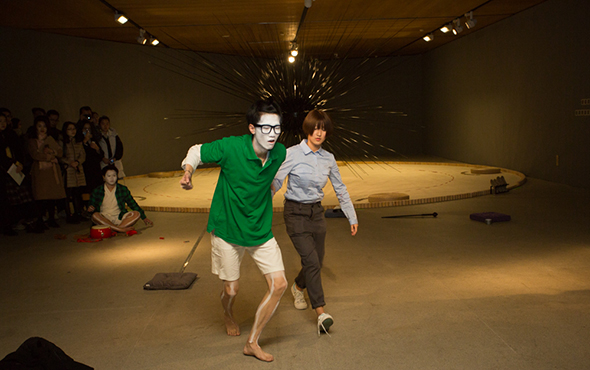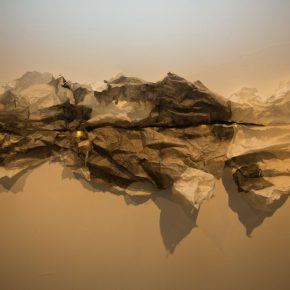
Since the founding of CAFAM Biennial, it has been putting forward an academic speculation and response to the status of contemporary art and the Biennial mechanism, this started with the “Super Organism” and has resulted with “The Invisible Hand: Creating a Gesture”, they all reflect the function of the laboratory of thinking of CAFAM as a university museum. Since the theme of the third CAFAM Biennial “Negotiating Space: I Never Thought You Were Like That” was announced, it has started many explosive discussions, but the thematic exhibition of the post-modern network language also means that CAFAM Biennial has stepped forward to question the exhibition mechanism. “Space” is a very important word in the whole system of art history, and the relationship between art and space also influences the developing form of art history, not only in theoretical research or curating practice. “Negotiating” is another key word in the exhibition, which is another strategy of game playing between art and space in this new context.
The theme of the Biennale is “Negotiating Space”, where the space is not just a physical architectural space for the presentation of work, although we can see that many works have been negotiated using space for the final presentation of the exhibition, for example, there is a long sloping channel connecting the ground floor and the second floor, presenting the work entitled “Sisyphus’s Ball” by the participating artist Yi Yuxiao. Punished by the gods, Sisyphus pushed the “boulder” to the top of mountain day after day, the “boulder” in the corridor of the art museum’s slope acts as an obstacle to the road of art, and it hopes the audience will respond to this, either choosing to push it, or taking a detour.
But the exhibition suggests a space that reveals a collision between social space, ideological space, virtual space, and mental space, which is like a steel jungle constructed using scaffolding in the exhibition site, it is a spatial concept of infinite extension. Of course, as an artistic space, Bourdieu put forward the idea of “Field Theory” has greatly expanded the artistic energy which can becarried by the art space. Since Duchamp, we have often seen bizarre things in the art exhibitions, and we will not be dismayed any more. The development of post-modern art has further narrowed the distance between the art and life, social space, sometimes with both being completely integrated into one, the development of art is no longer confined to the usual space of an art museum, so public squares, shopping malls can also become the site of art.
Although the public felt fresh or even strange during the period of the planning of the Biennale, they have never thought that CAFA would hold a Biennale in such a form. “Negotiating” is the basic mode of work of the Biennale, abandoning the traditional curatorial model, and the curators change to become coordinators, together with other coordinators of different identities, to have an equal negotiating and exchange in the artists’ programs, striving to find the best mode for the landing of the program. The democratized working mode breaks through the traditional mode of the one-way selection of artists by curators, weakening a fixed standard of judgment, reflecting an openness and freedom. Each program participating in the negotiation is screened in a video-styled manner in the exhibition hall, including the programs that eventually failed to participate in the negotiation and the behind the scenes of the exhibition organization is also part of the exhibition.
Curators play a very important role in the “art field” in China, but under the Chinese art environment, influenced by the system and capital, the identity of the curator is quite a mixed bag, which directly leads to the diversified appearance of the exhibition, and some curator’s ideas run through it from the top to the bottom, and it was once reported that “Nobody is a curator, and nobody is not a curator.” Although the Biennial takes “negotiating” to replace “curating” which might not be a perfect mechanism for the exhibition, but it is at least a reflection on the existing state and the way out, and also a recessive confrontation between the Biennial art and the “social space”.
In addition to the venues of the Biennial exhibition, it has also been extended to the Wangjing Hospital, 798, Huajiadi Experimental Primary School, Raffles City Shopping Center, which is a surprise for many people. Although during the period of the Biennale, General Counsel, Director of CAFA Art Museum Wang Huangsheng explained that, “The problems with life, growth of children, consumer society and other issues discussed by the artists have also entered the corresponding public space.” It is not a new attempt for a shopping center to hold an art exhibition, K11 and Parkview Green had also been involved in this, but it is unavoidable for the public to wonder how to realize it in the public spaces such as hospitals and primary schools? What kind of art works are suitable to display in these spaces?
Duchamp relocated a urinal into the exhibition hall, which can also be regarded as negotiating the space for art, the exhibition hall itself is an “art field”, carrying the social space and psychological space of art. However, this logic is not simply inverted, if Duchamp’s urinal as a work of art is moved back to the bathroom space, how would we see this “negotiating space”? Is it still art?
It is easy for the psychological spaces of the shopping center and the art to fit in with each other, for the shopping malls, an art exhibition is only the divergence of consumption and leisure on the cultural level for the public in the malls. The social space of hospitals and primary schools has a stronger and special nature of reference, reaching birth and death, and basic education. Therefore, the exhibition has a new topic in the negotiation space, is there a new spatial confrontation between negotiated spaces?
Is there a conflict between the spatial order created by the art exhibition and the emotions of the original space? The participating artist Zhang Yanzi has been exploring the combination of traditional Chinese ink painting and contemporary medical topics, discussing the topics related to art and the body, treatment, and her art continues with the proposition of “medicine healing the body, art healing the mind”. Zhang’s exhibited work uses cinnabars in gauze to depict the traditional pattern of Chinese landscape painting, and cinnabar represents the image of blood, which also perfectly coincides with the medical gauze in this context. This work is on display in the registration hall of Beijing Wangjing Hospital, the crowd coming and going to the hospital is undoubtedly the largest audience, including both the parents meeting new life and the patients who are registering, different identities have different emotions, perhaps some patients think it a good experience, appreciate the art while going to hospital, or perhaps some patients feel uncomfortable when presented with these images. The artist also believes that the strength of art works is weak in the face of birth and death, and even doubts whether it makes a fuss about an imaginary illness.
A consultation of art and space is necessary and it is not only the requirement of self discipline for artistic development but also the public life-related sociological topic, but this kind of negotiating is also apprehensive. After all, different spaces carry their own demand for function and interest, which has a variety of collisions with the art, rather than forcibly intervening with it. After visiting the exhibition hall, the writer can’t help but think of a famous case in art history: the minimalist sculptors Richard Serra was commissioned to create a 37 meters long and 3.7 meters high giant steel sculpture “Titled Arc” in the Federal Plaza in New York, but it was accused of hindering pedestrians who crossed the plaza and finally it was dismantled. Perhaps this confrontation and conflict also illustrates the theme of this biennale “I Never Thought You Were Like That”.
Text by Zhang Wenzhi, translated by Chen Peihua and edited by Sue/CAFA ART INFO
Photo by Yang Yanyuan/CAFA ART INFO












































































